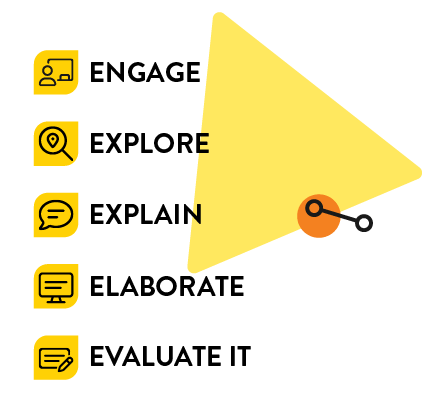The 5E Model: The Cornerstone of Science Education

Are you hoping for elementary science lessons that excite young students with active, engaging, and thoughtful content? Science4Us is the answer. Because Science4Us uses the 5E Model, young scientists investigate concepts through a flexible, interactive approach. Each new “E” builds upon the last as students successfully navigate through important science skills at the kindergarten, 1st grade, and 2nd grade levels.
What is the 5E Model?
Developed in 1987 by Roger Bybee and a team at the Biological Sciences Curriculum Study (BSCS), the 5E Model encourages active learning environments where students use collaboration, problem-solving, and investigation skills. It’s a constructivist model with prior knowledge as a bridge to comprehend and integrate new concepts. The 5E Instructional Model encourages students to question, observe, analyze, and draw conclusions while learning science.
Exploring the 5E Instructional Model components
It’s never too early to introduce young learners to science. The 5E Instructional Model provides a structure that connects students’ experiences with scientific principles and applies that knowledge to new situations. Lesson plans for interactive science education engage students with inquiry-based approaches.

Initiating inquiry-based approaches: The Engage phase
The first part of the 5E model, Engage, is all about student engagement. It introduces the new science concept by determining prior knowledge while revealing any misconceptions. Online Engage activities in Science4Us include an interactive digital notebook followed by a short video clip, an additional follow-up digital notebook activity, and listening comprehension questions. The offline Engage lesson is a hands-on activity that can be used with the whole group, in centers, or 1:1.
Facilitating active learning: The Explore phase
Following the Engage is the Explore. When kindergarten, 1st grade, and 2nd grade students Explore, they have the opportunity to “play” as they identify and develop their current understanding of the foundational science concepts. While generating new ideas, younger elementary students will begin to develop their own questions. The offline Explore worksheet builds critical thinking skills. This handout provides students with a hands-on, inquiry-based science activity that further enhances their ability to ask questions.
Encouraging conceptual understanding: The Explain phase
During the Explain phase, elementary students are provided a clear, concise description of the new concept, which includes formal labels and essential vocabulary through a fun and captivating video clip. A “Show What You Know” game-show-like assessment checks for student understanding within the Explain segment. The offline lesson is a graphic organizer or mind map that also determines mastery of the foundational science concept.
Enriching learning experiences: The Elaborate phase
The Elaborate phase of the 5E Instructional Model provides in-depth learning experiences. Science4Us blends literacy, technology, and engineering components through game-based activities. Kindergarten, 1st grade, and 2nd grade students investigate science concepts enhanced by cross-curricular lessons. Offline handouts include literacy skills, such as compare and contrast, fluency, categorizing and classifying, and creative writing.
Assessing learning: The Evaluate phase
The final phase of the 5E model is the Evaluate. This was designed to assess overall student understanding of the foundational science concepts. The online interactive science assessment is graded automatically for teacher viewing. The offline assessment is specialized for kindergarten, 1st grade, and 2nd grade, including a standardized test prep version.
Enhance K-2 science education with the 5E model and Science4Us
With online and offline lessons, Science4Us effectively utilizes the 5E Model to foster curiosity about science concepts in younger students. Science4Us exposes students to Physical Science, Life Science, Earth and Space Science, and Inquiry Science methodically to increase overall retention of the standards-based content. It not only represents a solid instructional model for diverse student populations but also includes cross-curricular lessons with reading, writing, math, technology, and arts to promote student learning. It’s all wrapped up in a program designed to evoke the interest and curiosity of all learners in kindergarten, 1st grade, and 2nd grade.
Science4Us uses the 5E Model to deliver foundational skills in the best possible way to our early elementary school science learners. Have you been waiting for something like this to share with your students? Start your free trial today!
